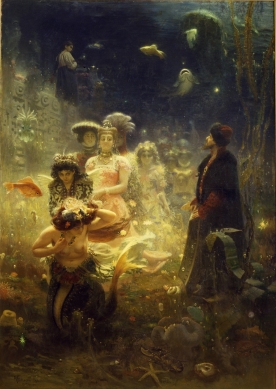Growing up, my bedtime stories were the works of H.P. Lovecraft (as well as Edgar Allen Poe, and Doctor Seuss. This may explain a bit about me). The Shadow Over Innsmouth particularly came to life for me; it left such an impression that I enjoy ocean-centered nightmares to this day. Imagine my delight, then, on discovering a blog post about the Orkney Finfolk, a group of gloomy fish-people who like to steal humans and live in an ancient city at the bottom of the sea (*ahem* Ph’nglui mglw’nafh Cthulhu R’lyeh wgah’nagl fhtagn. I should mention that I’m not the first one to make a connection to the Cthulhu mythos, either). These Finfolk have a lot in common with the fishy villagers of Innsmouth, but are–perhaps literally–several centuries older.

Something like a Finwife, courtesy of Wikimedia Commons.
Superficially, the Finfolk seem kin to mermaids or selkies, but you’d be a fool to mistake them as such. They come in two genders. Finmen at first appear like any other man, but a closer look reveals that their “clothes” are actually artfully folded fins arranged specifically to fool humans. Their faces are dark and gloomy, their eyes black. Finwives, on the other hand, look more or less like mermaids (unless they look like old hags, but we’ll get to that in the moment). Topless in the freezing North Sea waves, they dust themselves with crushed pearls and cry out at fisherman. These are the Finfolks’ natural forms, but really they might appear in any form, as they are accomplished sorcerers and shapeshifters. They might show up as driftwood, as a tree, as someone close to you…
Nothing stops the Finfolk from crossing from sea to land: unlike selkies, they come and go as they please (several sites describe them as “amphibious”). Their motivations for venturing into human territory are two-fold: 1) to cheat or otherwise obtain silver, which they are obsessed with, and 2) to steal humans, whom they will drag away screaming and then force into permanent matrimonial servitude.
Obviously, this latter threat is what the people of the Orkney islands were most concerned with. They told stories all the way up through the 19th century of women disappearing off beaches and men out of boats; spouses abducted onto crafts that flew across the waves with unnatural speed; floating plants bursting to life to snatch a passerby into the cold, grey water. Depending on the season, the kidnapped’s destination was either the magical, vanishing island of Hildaland or the fearful Finfolkaheem, an opulent kingdom at the bottom of the sea. Both are described as Finfolk utopias, though for the human captives, they would be more like hell.

Underwater Kingdom painting, courtesy of Wikimedia Commons.
First there is the particular torture of the places themselves. Hildaland is guarded by monstrous whales and hideous tusked Finmen, so good luck getting rescued out of there, never mind escaping it. It’s surrounded by mist; mortal boats might pass straight through it without realizing that it’s there (if they’re lucky). Finfolkaheem is even worse, though it would certainly be interesting to see. Full of massive crystal halls, multicolored seaweed, tiny phosphorescent creatures, and curtains fashioned after the aurora borealis, the Finfolk raise sea-cattle, ride sea-horses, herd whales, and train sea lions within the city’s borders. For humans, it’s a prison of the worst sort: there’s no escaping from the bottom of the ocean alive (no word on how the Finfolk keep them there to begin with. Sorcery?). That deep, the pressure and darkness alone would be enough to drive you insane.
Worse than the supernatural prisons are the Finfolk spouses themselves. Finmen are notoriously cruel and territorial, even to people they’re not married to (for example, they’ll stab secret holes in the fishing boats that cross them, enjoying the panic of fishermen that realize, too late, that the ocean is swallowing them alive). One of the reasons Finfolk prefer to marry humans (as opposed to each other) is because Finwives age much faster when coupled with their own species; I can only guess that this is because Finmen are moody pains in the a** and beat them mercilessly if they don’t bring home enough silver. The ladies aren’t blameless, though…Finwives pummel their human spouses just as cruelly, and for the same reason. Human spouses of either gender are worked to death, helpless in the face of monsters as old as the ocean itself.

Eynhallow in 1980, courtesy of Wikimedia Commons. It does look kind of decimated, doesn’t it?
But some people fought back, and that’s why we don’t see much of the Finfolk today. You see, the Finfolk greed for silver can be turned against them: throw a handful of coins away from yourself, and you might outrun your fishy pursuer. The Finfolk also hate pure salt, which one man in particular took advantage of. After a Finman stole his wife, the Goodman of Thorodale laboriously figured out where Hildaland was, boated out there, out-bluffed the terrifying creatures in the water, landed on the island, took out a bag, and rained salt everywhere. The Finfolk fled screaming into the sea, taking their livestock and prisoners with them. Their fields dried up, and Hildaland ceased to be a magical place. Now it is called Eynhallow; you can visit it today.
The final nail in the coffin for the Finfolk seems to have been the arrival of Christianity. Accounts claim that the Finfolk abhor crosses, and the more that appeared on the islands, the deeper they dove. After the 19th century, there ceased to be much mention of them at all.
That doesn’t mean they can’t still be out there, though. Deep beneath the North Sea waves. Dreaming.
How long can you hold your breath underwater? How about in the face of nameless horror? Share your story in the comments below.
Featured image by Jana Sabeth.





Awesome! Thank you for linking to my article. I did wonder if Lovecraft was influenced by Orkeney folklore. I’m genuinely not sure, since his article about supernatural horror expressed a distinct dislike of “professional occultism”, although he did have some fairly classical mythological leanings. Still, though, it’s one heck of a coincidence…
Yeah, one has to wonder. It might just be one of those weird things that humans tend to dream up on their own (like vampires or ghosts). Loved your post!